by Heather Kolesa | Nov 8, 2016 | Y2K9s News
[cro_halves_layoutstart]
The membership meeting on November 5th turned was an entertaining and informative event. After a delicious meal from Zoe’s, Upper Moreland K9 Patrol Officer Brian Scott and his partner, Dex, provided a fascinating presentation complete with a bite demonstration. The membership meeting included an update of transitions on the board and forthe registrar, as well as some other important information about the club and its members.
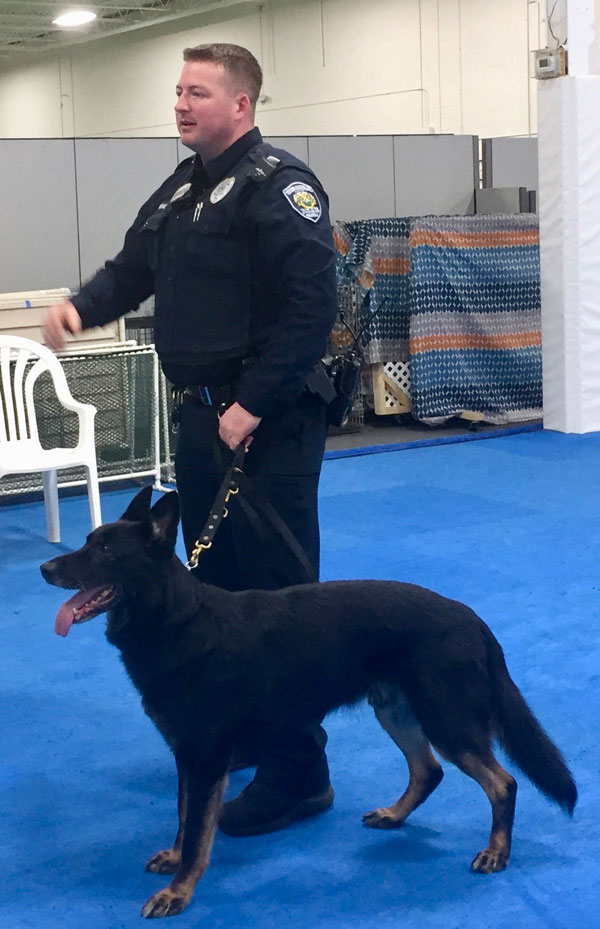
K9 Patrol Officer Brian Scott and Dex
[cro_halves_layoutmid]
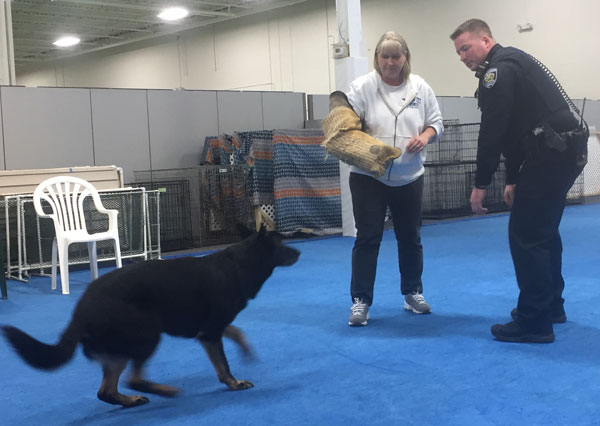
This is Joyce Smuda taking a bite from Dex.
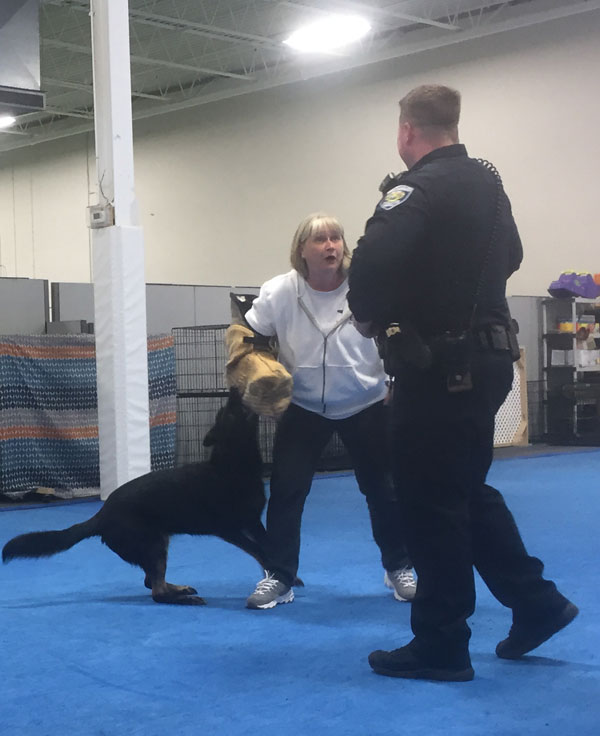
[cro_layoutend]
by Heather Kolesa | Sep 22, 2016 | Y2K9s News
“The first time I met Katie, she was training to run a marathon,” says Rosie Sutherland, Y2K9s’ director of Agility. That drive to excel has been a guiding force in her life, and helped propel Katie to four international agility competitions, the most recent one this summer. It all happened in a surprisingly short period of time. Sally Silverman recalls when Katie “was a newbie. I showed her the ropes. Now she’s the international competitor who can pull a streak of 12 or more blue ribbons in a single weekend – truly a reflection of her hard work and dedication.”
Katie started taking classes in 2000 with Oreo, her first Sheltie. Her second, Chip, became a local agility star. Twix joined the pack in June, 2003. Though Katie did well with Oreo and Chip, it was Twix that made the difference, according to Rosie. “He was so much more competitive,” she explained, “so focused. He always wanted to keep working, no matter what.” He was the ideal partner for Katie. With both team members pushing their limits, they were flying to Arizona for USDAA Nationals by 2005. Two years later, agility champion Karen Holik saw Katie and Twix in action at an agility seminar, and encouraged her to try out for the AKC World Team.
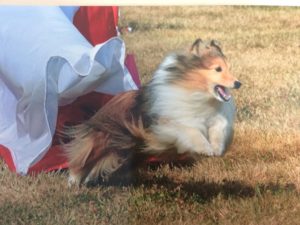
Ritz in action
They did, in 2007 and 2008, while honing their skills at the AKC Nationals as well. In 2009, they made the World team, and it was off to Austria. In the first international competition they ever entered, Katie and Twix finished 5th in the world in the individual competition.
Year round-training for Katie and Ritz includes a full schedule of conditioning routines, with special emphasis on flexibility for both team members: “I think if you’re doing a lot of competing, you and your dog need to be in good condition,” she says. “And that includes a lot of stretching to keep both of you limber.” To that end, Katie works out and sees a chiropractor regularly, while Ritz has regular visits with a chiropractor and a physical therapist.
So how do you get to Ruitz? Practice! Practice! Practice!
In late July, Katie and Ritz, her seven-year old Sheltie, flew to France to compete in the European Open 2016. After a day of sightseeing in Paris, Katie and Ritz traveled by bus to Ruitz (formal name: Maisnil-lès-Ruitz) for two days of practice. The official warm up, vet check, and opening ceremonies followed, culminating in two days of competition. The team came home on August 1st.
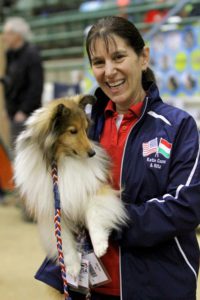
Katie and Ritz
“I had a great time,” said Katie a couple of days after she returned. “But we didn’t do as well as I had hoped. You just don’t see that level of competition in this country. It’s so much faster, more intense – everyone is going for the win every time.”
In addition, European agility courses differ from those we see in this country. They are set up for speed, and their challenges are much greater. As Katie points out, “The courses that we run here are required to have the table and tire in every single course, no matter what the dimensions of the venue.” European judges don’t have to include every element in every course.
European courses also cover a lot of territory, and are governed by different regulations. As a result, European judges can construct all kinds of challenges within their courses. “There were seven back sides in one of the courses we ran,” marvels Katie. “You’d never see that in the US. On top of that, the Europeans are used to competing in those kinds of courses. We aren’t.”
Katie sends a giant thank you to “everyone who supported me by buying T-shirts and magnets, and to all who encouraged me – it meant more than I can ever tell you.” And she’s already preparing for Italy 2017, “concentrating on taking as many seminars and lessons as I can with people who can help me improve.”
That concentration, that intensity that Katie exudes is legendary among Y2K9ers. It was in Rosie’s classes that Janie Harris first got to know Katie, who soon took Janie and her dogs, Booker and Bailey, under her wing. Katie rarely hesitated to give advice, usually beginning with, “Janie, you need to....” Janie recalls a time when their class with Rosie was switched to a later hour. “I can’t possibly get up at 5 am to teach and still do this class,” Janie confessed to Katie. “Janie, you need to man up and do what’s right for your dog,” was Katie’s reaction. Janie dutifully signed up. At the end of the first class, an exhausted Katie turned to an equally exhausted Janie, telling her, “OMG, we are never doing this again.”
Katie’s single-minded focus carries over to her classes, which, as many Y2K9s students know, are usually energetic, and often demanding. But as Rosie points out, she’s also “very supportive, and will always be there for you. I think she’s a natural-born teacher.” This reporter was in Katie’s classes for several sessions in the early stages of our agility training. One evening, she set out an unusually challenging course. I remember feeling pretty good about the evening. The next day, I found an email from her in my inbox:
From: Katie Abrams <oreochiptwix@yahoo.com>
Date: May 14, 2008 5:51:07 AM EDT
To: Barbara Silverstein <basilverstein1@verizon.net>
Subject: class last night
Barbara - you & Lucy were spectacular! I really enjoy watching you both develop as a team. You handled her beautifully, and she knew exactly what to do! Keep up the hard work.
I have kept it to this day.
So congratulations to you, Katie, for your amazing spirit and ability, as teacher, colleague, and competitor. The entire club will be cheering for you, all along the way to Italy.
Barbara Silverstein is a Y2K9s Member and co-editor of Chew On This.
Watch these videos of Katie and Ritz in action:
[cro_video no="https://www.youtube.com/watch?v=DVJb5yCr10U&feature=youtu.be"]
[cro_video no="https://www.youtube.com/watch?v=YVh8cT4l1KY&feature=youtu.be"]
[cro_button text="Back to Chew on This Vol. 1, No. 3" link="http://us9.campaign-archive1.com/?u=6e209ceaaa80d7f3a608371e7&id=43bfb6e6dc&e=bec7545c5c" color="1"]
by Heather Kolesa | Sep 22, 2016 | Y2K9s News
[cro_thirds_twothirds]
You wouldn’t dream of driving without making sure your kids are safely buckled up, or strapped into their car seats. You probably buckle up yourself – it is the law, after all. But what about your dog?
According to the US Census Bureau, there were 10,800,000 motor vehicle accidents reported in 2009. “A dog is just as vulnerable to injury in a collision as we are,” says Dr. Debbie Mandell of Penn Vet’s Ryan Hospital and a pet expert for the American Red Cross. One of the worst cases she’s seen involved a collie that was thrown forward from the backseat and sustained a broken back. “I always advocate some sort of restraint for a dog travelling in a car,” she says. And just like a small child, a dog riding in the front seat can be injured, even fatally, by an airbag deployed in a crash.
There are other powerful reasons for restraining your dog. A 60-pound dog traveling at 35 miles an hour can become a 2,700-pound projectile in an accident. Imagine that hitting the back of your head.
An unrestrained dog can even cause an accident. A friend tells of her German Shepherd playfully putting his paw on the steering wheel, causing her car to crash into a tree. A news report described a fatal crash in which one of the drivers was distracted when his dog jumped into his lap.
Frightened by the trauma of a crash, dogs have been known to jump out of a car and run away, or be struck by another car on the road. If the dog doesn’t leave the vehicle, it could hinder rescuers.
Finally, states and municipalities have been enacting ordinances requiring restraints for dogs in cars, with fines of up to $1,000, and, in some cases, prosecution.
What are your options?
Crates are a common choice. Barriers that confine the dog to the cargo area, seatbelt harnesses, and travel carriers are also available. There are pros and cons to all of them. Unfortunately, such agencies as the US Department of Transportation, the Insurance Institute of Highway Safety, AKC, ASPCA and the National Highway Traffic Safety Administration show inconsistent data on the safety of these options. Until better studies are available, choose the solution that best serves both you and your dog.
The crate
A crate will prevent driver distraction and may keep the dog safely inside the vehicle. It might also prevent injury to other occupants in a crash if it is properly secured, and the impact is minimal. Ditto a plastic kennel. But there is little information on the crash-worthiness of most crates. An Internet search will turn up lots of amateur videos showing the relative safety of a variety of crating systems, but painfully little data to support claims.
The Variocage crate, by Mim Construction AB, is constructed of steel and equipped with an escape door, and is perhaps the only safety-tested crate available. However, test results appear to be inconsistent, and the crate is very expensive.
For use with a crate on a seat, PetBuckle® markets a crash-tested kennel restraint system. The crate sits lengthwise on the seat and is secured by two straps, distributing the pressure force in the event of a collision.
Crates should always be secured. Bungee straps, though popular, are susceptible to stretching and breaking. A ratcheting system coupled with high strength straps is the most reliable.
Custom crates are frequently seen in the rear areas of open vehicles at dog trials. Considerations should include durability of materials, ease of access from more than one side, and ability of the crate to be safely secured.
Putting up barriers
Another popular option, particularly with SUVs and station wagons, is a barrier placed between the cargo area and the back seat. This gives the dog some room to move around; it also means the dog could be tossed about in an accident. Metal barriers may keep driver and passengers from being hit by the dog, but mesh barriers will unlikely have the strength to keep the dog contained. And if the vehicle’s rear windows are broken in the crash, the dog has an easy access to escape. Another caution: barriers must be correctly and securely installed to be safe and effective.
Belting them in
When it comes to securing your dog in the car, there are many versions of pet harnesses to choose from. Made of a variety of synthetic fabrics, the harnesses clip to seatbelts or provide a loop through which the seatbelt can pass before being fastened. Some can be attached to the vehicle using the anchor points used to secure child safety seats.
When choosing a harness, consider fit and strength of materials. Ideally, it should attach to the buckle part of the seat belt apparatus, rather than the belt itself.
Boosters for small dogs
A small dog booster or car seat may prevent the dog from wandering around the car, but not much more. When used in conjunction with a harness and secured properly, it may prevent the dog from being hurled forward in a collision. The same guidelines that apply to harnesses for larger dogs will apply to those for small dog booster seats. But no matter which one you choose, the dog is still in danger of injury or death when an airbag is deployed.
The last word
Restraining your dog when traveling will make your ride, your passengers’ rides, the dog’s ride, and even the rides of others on the road safer. However, the choice for making car travel safe for your dog is not an easy one. Once you’ve decided on your method of restraint, look for the product that best fits your needs. Durable materials are a must, as well as a system that will not give way in a collision. Contact the manufacturer of a product you are considering to ask if they have done any crash testing. If so, ask where you can read about it.
Dogs are such an important part of all of our lives. By all means, bring them along, but make sure they are safe on the way.
[cro_thirds_onethird]
Mention auto safety and cars, and everyone has a story.
Here are just a few:
- A dog sitting on the front passenger seat was thrown into the dashboard, sustaining a fatal head injury.
- A collie riding in the back seat was thrown over the front seat when the car was involved in a collision, breaking the dog’s back.
- Three dogs and their owner were uninjured in a collision on a highway, although the dogs were able to exit the auto. The owner took off after them. Two of the dogs and, sadly, the woman, were then hit by other vehicles and killed.
- A Labrador lying on the back seat was thrown forward when the car he was in rear-ended another. Damage was negligible; insurance information wasn’t even exchanged. The dog’s injuries, however, were fatal.
[cro_layoutend]
Sally Silverman is a long-time instructor at Y2K9s, and a freelance writer
Thank you to Clean Run for allowing the use of this article, originally printed in their June, 2012 edition.
[cro_button text="Back to Chew on This Vol. 1, No. 3" link="http://us9.campaign-archive1.com/?u=6e209ceaaa80d7f3a608371e7&id=43bfb6e6dc&e=bec7545c5c" color="1"]
by Heather Kolesa | May 9, 2016 | Y2K9s News
Some changes with aging are inevitable, but as our dogs grow older, we can take several steps to help maintain their quality of life. Prevention, monitoring, and maintenance are keys to keeping senior dogs healthy and active, in conditions from periodontal disease to diabetes.
Y2K9s Member Samra Elser gave a presentation on this topic at the April 19 Membership Meeting, and recommended several methods for monitoring and protecting our dogs:
- Annual or semi-annual veterinary exam
- Complete blood count, chemistry panel (add thyroid if not already included), urinalysis
- Regular dental exams with professional cleaning (every six to twelve months) and extraction of diseased teeth if needed
- Maintain lean body condition (proven to increase longevity)
- Teach hand signals to maintain communication (hearing and/or other senses often become impaired as dogs age)
There are also things we can do to make our homes more amenable to an aging dog’s needs:
- Provide non-slip surfaces and ramps or stairs
- Keep toenails and hair on paws short to increase traction
- Allow access to soft bedding
- Climate control (warm and cold)
And perhaps most important, by continuing our interactions with our dogs, we can maintain certain routines and adjust others as needed:
- Maintain routines (important as a dog’s senses grow compromised)
- May need more frequent bathroom breaks
- Monitor bodyweight and increase or decrease caloric intake
- Exercise at ability-appropriate level
- Continue sports if desired
- Endurance (trotting or swimming)
- Strength (target hind limbs and core)
- Treat discomfort if needed (NSAIDS such as Rimadyl (generic name Carprofen), Deramaxx (generic name Deracoxib), and others
We all know how frightening a diagnosis of cancer can be. For many types of cancer, early detection is critical. You can check your dog for possible early indications using the following practices:
- Perform monthly mammary exams on female dogs
- Palpate testicles on intact male dogs
- Arrange for your veterinarian to perform rectal exam annually
- Examine your dog frequently (including mouth, eyes, and ears) to identify superficial masses
- Abdominal ultrasound may identify tumors, but is impractical for routine screening
Samra’s talk was a farewell to the club, at least for the short term. Her veterinary training now requires her to take a leave from teaching at Y2K9s (she is working toward a combinedVMD/PhD). We wish her well and look forward to her return.
[cro_button text="Back to Chew on This Vol. 1, No.2" link="http://us9.campaign-archive1.com/?u=6e209ceaaa80d7f3a608371e7&id=baed600532" color="1"]
by Heather Kolesa | May 9, 2016 | Y2K9s News
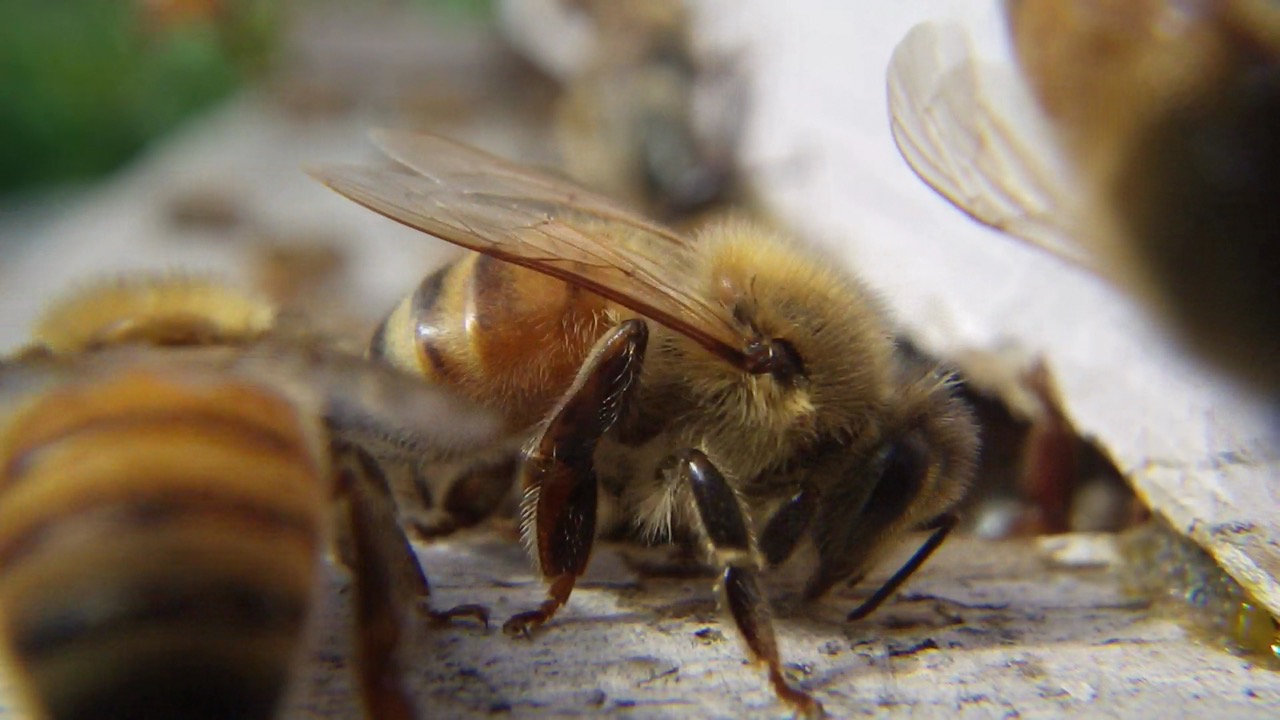
Photo credit: Jon Snyder
By Christina Fuoco, VMD, CVA, CCRT
Medical Director
WAG: Whole Animal Gym
Spring has sprung and the bees are buzzing! With bees, comes honey. And honey benefits dogs and their owners.
Honey dehydrates bacteria – which makes it a very effective antibacterial. A 2016 study concluded that “the healing process of the surgical wound and its final aesthetic result could be improved by using honey dressing.” Honey may also help with allergic reactions. How?
Honey also helps relieve inflammation and seems to help with allergies, though here there is some debate. Doubters question whether there is enough pollen in honey to help build immunity. Supporters believe that a smaller quantity is more likely to affect the immune system just enough to keep it from generating an immediate allergic reaction. That in turn enables the immune system to become accustomed to having that pollen around. When pollen season arrives, the immune system is no longer programmed to react.
For allergies, be sure to choose raw honey, collected locally. Too much processing tends to affect the enzymes. And if the honey isn’t local, it likely won’t have the right pollens.
But if you or your dog has had anaphylactic reactions to bee stings, you should consult with your doctor about the risks of eating raw honey.
For a fascinating look at beehive activity, click here: House party at the hive
Dr. Fuoco is a traditionally trained veterinarian with additional certifications in canine rehabilitation and acupuncture. She has developed a holistic approach to her medical practice, balancing the best of Eastern and Western medicines. Her husband keeps bees and sells raw local honey for dogs at WAG.
[cro_button text="Back to Chew on This Vol. 1, No.2" link="http://us9.campaign-archive1.com/?u=6e209ceaaa80d7f3a608371e7&id=baed600532" color="1"]






